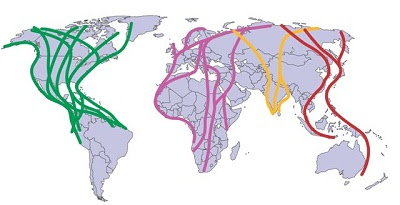 |
| A "flagged" migratory bird at Sungei Buloh. Flags are used to study these birds which travel huge distances. photo by David Li on the Sungei Buloh Engraved Flag Sightings FB page |
"Networking for migratory birds" is the 2013 theme for World Migratory Bird Day. Migratory birds travel huge distances and rely on a network of sites that act like 'stepping stones'. These sites are important for resting, feeding, breeding and wintering.
 |
| This map shows in different colours the main routes that birds use on the annual migrations. From the World Migratory Bird Day website |
This year's theme also highlights the importance of networking amongst people to conserve migratory birds by establishing global connections!
What are migratory birds?
Migration is a natural process. Various kinds of birds fly over very long distances (hundreds and thousands of kilometres) to find the best habitats to feed, breed and raise their young. As low temperatures make conditions at breeding sites unfavourable, migratory birds move on.
 |
| Sungei Buloh Wetland Reserve regularly monitors migratory birds that visit the Reserve. Photo by David Li with a summary of shorebird counts for 2012. |
Migratory birds are perfectly adapted to fly fast and across long distances. Nevertheless, their journey is often an exhausting one during which they go to their limits. Our wetlands and shores such as Sungei Buloh and Chek Jawa are important rest stops where migratory birds can replenish their energy and continue on their journey.
Migratory birds have to cope with a scarcity of food, stopover sites that are shrinking in area, predators, hostile weather and the expanse of seas, huge mountains and endless deserts.
Many migratory birds have little choice when it comes to the selection of suitable areas to use. They need access to specific sites located along their migration routes. If one of these important sites is damaged or destroyed, often it means disaster for the birds that depend on that site.
Read about these threats on the World Migratory Bird Day website.
What about seabirds?
Besides the migratory birds that we can see resting and feeding on our shores and mudflats, there are also awesome seabirds that spend most of their time on the open seas. These have been seen in Singapore waters!
 |
| Survey area by the Pelagic Team, May 2013 from Con Foley's blog |
 |
| Photo by Con Foley from Con Foley's blog |
Besides sea birds, the Pelagic Team also spots dolphins!
 |
| Photo by Con Foley from Con Foley's blog |
Where can you see migratory birds in Singapore?
Although there are no dedicated events in Singapore to celebrate World Migratory Bird Day this year, you can make your own visit to the boardwalks at Sungei Buloh and Chek Jawa to check them out on your own.
Or join these scheduled guided tours to our wetlands. I'm sure the guides will be able to show you some migratory birds!
- Mandarin guided tour at Sungei Buloh
- Birdwatching at Kranji Marshes with Nature Society (Singapore)
- Mangrove walk at Sungei Buloh
More about migratory birds
- Shore birds on wildsingapore.
- Shorebirds and waders on the Bird Ecology Study Group blog.
- More related links on the World Migratory Bird Day website.
